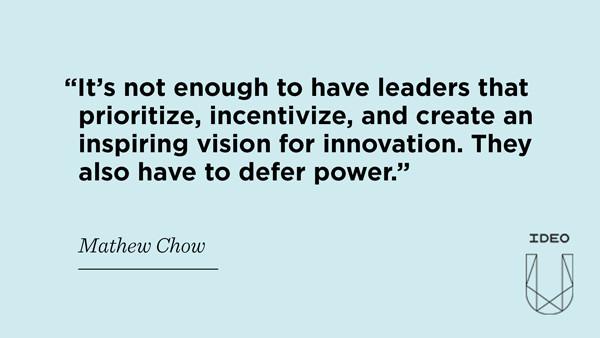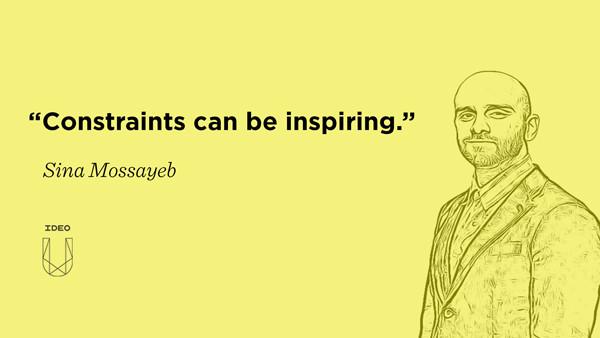How to Overcome Barriers to Innovation in Your Organization
It happens to the best of us. You’ve got a great idea and you’re excited to make it happen. But when you introduce this brilliant gem to the organization—wham! Up go the roadblocks. Obstacles to innovation can creep up when you least expect them.
Don’t worry—being aware of the roadblocks to new ideas can actually help make you, and your team, stronger. We asked a few trailblazing IDEOers to share their most helpful approaches to overcoming barriers.

Make People Part of the Change
Joe Brown, Portfolio Director
I can’t stress the role of emotion enough. Two things that don’t seem to get enough consideration in building and changing organizations that innovate are emotion and motivation.
One of the biggest barriers to innovation is politics—people are motivated by a blend of saving face, maintaining momentum, and being recognized as a hero. Too many innovation efforts disregard the past and somehow we’re surprised when people who represent the past don’t embrace new ideas. This is why it’s important to make people part of the change from the beginning—if they don’t create it, they’ll feel threatened by it. And, if they feel threatened, they’ll fight back.
Rally Support with Purpose Driven Stories
David Aycan, Products Lead
Endorse channels of communications that allow employees (or even customers) to share stories representing the organization's purpose. Progressive organizations often recognize that other companies and individuals are in pursuit of the same big goals. And in response create communities of passion that share praise for those outside the company who act towards the same purpose. It’s always easier to get your new idea adopted when people are already primed to be excited about it. Two examples that come to mind around purpose are CVS helping people on the path to better health and a former P&G executive tearing down the stock price tickers in the office and replacing them with images of customers they were serving.
Empower Middle Managers
Mathew Chow, Design Lead
In larger companies, middle managers need to be selected, trained, and empowered to drive innovation strategies. It’s not enough to have leaders that prioritize, incentivize, and create an inspiring vision for innovation. They also have to defer power. In particular, they need that power to go to good managers who can execute on their innovative strategies and systems. One example of this approach comes from the decentralized leadership espoused by retired Navy Seal commander, Jocko Willink, who saw that Seals on the ground needed the ability to react quickly to rapidly changing situations in combat. Innovation really does have to move both up and down the chain of command. You might even discover a few rising stars in the process.

Reward Innovation
Deborah De Vries, Senior Organizational Design Director
Without sponsorship for innovation, it's difficult for people to feel safe to experiment, especially if individual goals don't align with organizational goals. Inevitably, the daily fire drill takes precedence. If innovation is truly important to the company's purpose, it should be built into “how” people get rewarded (annual compensation) and the P&L (experimental budgets). Some organizations celebrate and reward individual or team innovation successes through rituals, activities that can help nudge the culture of your team or organization toward behaviors that support creativity.
Get Untangled from the Jargon
Susan O'Malley, Head of Strategy Office of the CEO
At large organizations and those that have invested efforts in innovation, there's often a huge mismatch in what people call things. It’s easy to get lost in a jumble of jargon. If the stuff works, it shouldn't matter what you call it. People have a tendency to drown in the lingo, but a bit of listening and cooperation can go a long way.
Embrace Constraints
Sina Mossayeb, Senior Design Lead
One thing I've seen bring great success for those engaged in innovation work is constraints. It's counterintuitive to some, but constraints can create clarity. For example, the reason The Terminator story rests on the premise of an android from the future coming back to the "present" was due to a limited budget—they didn't have enough for special effects of the future. (Do budget constraints sound familiar in your organization? Use them as a constraint to fuel another round of iteration on your idea.)
Clarity of purpose enables people, teams, and organizations to design the right constraints that create conditions for innovation to emerge and be applied. Like the NASA Mars Rover team: they had a limited budget, limited weight, and limited time. However, their sole goal was to send 6 wheels onto Mars. Constraints can be inspiring.

Build new skills and learn how to move from ideas to real innovations in the marketplace. Check out our From Ideas to Action online course.
----

- choosing a selection results in a full page refresh
- press the space key then arrow keys to make a selection



